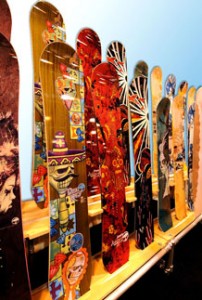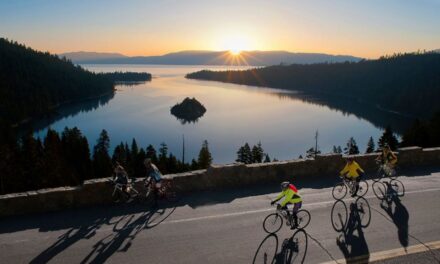- Tahoe’s Nevada Beach Tops the List of Hard-to-Book Campgrounds - 07/17/2024
- Cannabis Watershed Protection Program Cleans Up Illegal Grow Sites - 07/10/2024
- French Fire - 07/05/2024
I’m in the market for a new pair of skis. Are there skis being made today that are made with materials and processes that are kinder to the environment?
— Scott Paxton, Rutland, VT
Yes, in fact ski (and snowboard) manufacturers may be among the greenest sporting goods industries out there today, given the importance to practitioners of keeping our carbon emissions down—global warming is bad for skiing and boarding—and our alpine backcountry preserved.
Perhaps the biggest green change in the industry is the adoption of bamboo as a core material for both skis and snowboards. Bamboo is fast growing and doesn’t require much if any fertilizers or pesticides, so it can be produced sustainably. It is also rigid and hard to break. While most skis and snowboards on the market today still use more traditional hardwoods like beech, birch or aspen in their cores, bamboo is definitely coming on strong. Some of the leading ski makers leading the bamboo charge include K2, Salomon, Kingswood, High Society, Boomtown, Obsidian, Locomotiv, Liberty, and Blue House.
Bamboo isn’t the only green innovation in skis today. Switzerland-based Movement Skis uses wood certified by the Forest Stewardship Council (FSC). And Germany’s Grown Skis will recycle your old skis to make furniture and use remaining wood scraps in making new pairs of sustainably-sourced wood skis.
Another German manufacturer, Völkl, eschews fiberglass entirely in its Amaruq Eco skis. The wood core is wrapped instead with wood sidewalls and topsheet. And instead of using epoxy to bind things together, Völkl uses all-organic wood resin and then protects the skis’ wood surfaces with an application of linseed oil. The metal edges employ 60 percent recycled steel.
Sustainability is also the new normal in snowboards. California-based Arbor Collective uses sustainably sourced bamboo, natural wood veneer and poplar, respectively, in its three lines. Protective top layers are made from a 30 percent castor bean-based bioplastic and the edges are made of 60 percent recycled steel.
Salomon, one of the industry’s leaders, has pioneered using bamboo in its snowboard cores as part of its Green Initiatives for Tomorrow program. The company’s embrace of bamboo has helped it cut down significantly on toxic fiberglass resins while reducing the plastic content of its boards by some 25 percent.
Burton’s Eco Nico snowboard uses FSC-certified wood for its core, a lacquer-free top sheet, 90 percent recycled steel edges, 100 percent recycled sidewalls and a 50 percent recycled base. K2 Sports Fastplant snowboard uses bamboo for its core, and is deemed virtually unbreakable by the company. Another manufacturer, Washington-based Gnu, uses sustainably harvested Aspen trees for their snowboard cores.
Many other ski and snowboard makers have jumped on the green bandwagon as well. Indeed, there’s never been a better time to do the right thing by your snowsports equipment purchasing.
CONTACTS: Grown Skis, www.grownskis.com; Movement Skis, www.movementskis.com; Lucky Snowboards, www.luckysnowboards.com; Gnu Snowboards, www.gnu.com; Burton Snowboards, www.burton.com; K2 Sports, www.k2.com; Arbor Collective, www.arborcollective.com; Salomon, www.salomon.com.
EarthTalk® is written and edited by Roddy Scheer and Doug Moss and is a registered trademark of E – The Environmental Magazine (www.emagazine.com). Send questions to: earthtalk@emagazine.com. Subscribe: www.emagazine.com/subscribe. Free Trial Issue: www.emagazine.com/trial.














